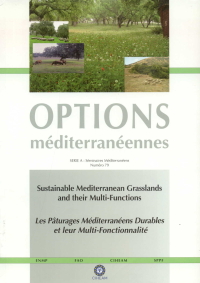| Article précédent | p. 93-96 | Article suivant |
Cover crops in vineyards for sustainable soil management
With the objective of evaluating and selecting cover crop pastures to improve soil management in vineyards cv. Cabernet Sauvignon, 5 cover crops were evaluated: (i) control without vegetation; (ii) control with spontaneous vegetation; (iii) legumes mixture of early maturing cvs. of Trifolium subterraneum and Medicago polymorpha; (iv) legumes mixture of late maturing cv. of T. subterraneum and T. michelianum; and (v) legumes mixtures of late maturing cvs. and Lolium rigidum cv. Wimmera. The three pasture mixtures realized large populations of plants; 600-800 and 900-1200 plant/m2 in the first and second growing seasons, respectively. Biomass production was significantly higher (P=0.05) in the mixtures with late maturing cultivars of T. subterraneum and T. michelianum. The contents of N, P and K in the biomass of the cover crop were higher (P=0.05) than those cover with spontaneous species, which allowed the content of available N to be increased in the soil. Also, higher contents of K and P were detected in the soil; the later was mainly due to the fertilization with phosphate during the establishment of the cover crops.
Dans l'objectif d'évaluer et de sélectionner des pâturages pour améliorer la gestion du sol dans des vignobles cv. Cabernet Sauvignon, 5 cultures de couverture ont été évaluées : (i) témoin sans végétation ; (ii) témoin avec la végétation spontanée ; (iii) mélange de légumineuses précoces cvs. de Trifolium subterraneum et Medicago polymorpha ; (iv) mélange de légumineuses tardives cv. de T. subterraneum et T. michelianum ; et (v) cvs. de légumineuse tardives en mélange avec Lolium rigidum cv. Wimmera. Les trois mélanges de pâturages ont donné de fortes populations de plantes; 600 - 800 et 900 - 1200 plantes m-2 dans la première et deuxième période de croissance, respectivement. La production de biomasse était significativement plus haute (P = 0,05) dans les mélanges à variétés tardives de T. subterraneum et de T. michelianum. Les teneurs en N, P et K dans la biomasse des pâtures était plus haute (P = 0,05) que celles du couvert à espèces spontanées, ce qui a permis d'augmenter la teneur en N disponible dans le sol. Egalement, des teneurs plus hautes en K et P ont été détectées dans le sol ; principalement en raison de la fertilisation avec du phosphate pendant l'établissement de la pâture.
- [ Afficher ]
- [ Télécharger ]
- [ Exporter la citation ]
Vous pouvez télécharger la citation au format :
- [ Imprimer ]
-
Mots-clés
AZOTE, COUVERTURE VEGETALE, EXPERIMENTATION, GESTION DU SOL, HERBAGE, LEGUMINEUSE FOURRAGERE, PATURAGES, PLANTE HERBACEE, VIGNOBLECiter cet article
Ovalle C., Del Pozo A., Lavín A., Hirzel J. Cover crops in vineyards for sustainable soil management. In : Porqueddu C. (ed.), Tavares de Sousa M.M. (ed.). Sustainable Mediterranean grasslands and their multi-functions . Zaragoza : CIHEAM / FAO / ENMP / SPPF, 2008. p. 93-96. (Options Méditerranéennes : Série A. Séminaires Méditerranéens; n. 79). 12. Meeting of the Sub-Network on Mediterranean Forage Resources of the FAO-CIHEAM Inter-regional Cooperative Research and Development Network on Pastures and Fodder Crop, 2008/04/09-12, Elvas (Portugal). http://om.ciheam.org/om/pdf/a79/00800624.pdf



